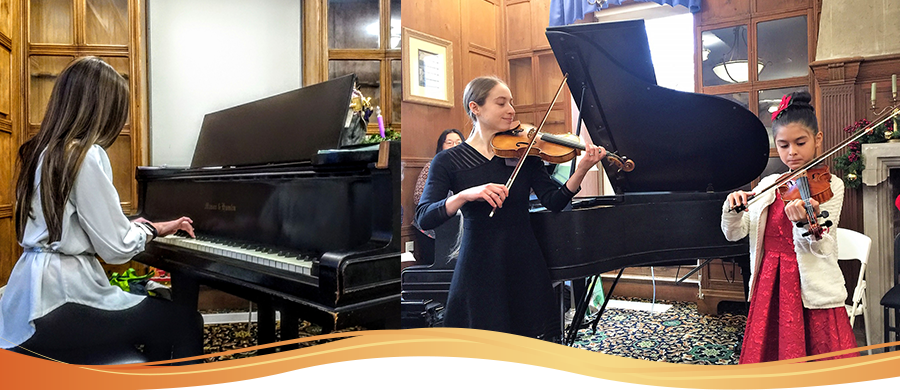
Online
Music for the Community
If you're interested in a particular category, you can sort performances by student age, instrument, singalong music, composer and so on - click on the orange tags under the text. We hope you and your family will enjoy watching our students share their music!
To have each week's videos and accompanying info sent to your inbox*, please subscribe via the orange button.
*Videos are delivered twice weekly; you can unsubscribe at any time, and we will never share or sell your info.
Subscribe to this Page
Displaying items by tag: Viola
Day 58 - Arpeggione Sonata by Schubert
Violist age 18 plays Arpeggione Sonata by Schubert
Franz Schubert (1797 – 1828) wrote this sonata in November 1824, for an instrument that had been invented only the previous year! It’s the only major composition for the arpeggione - basically a bowed guitar – that is still played today, albeit by other instruments.
The sonata was probably commissioned by Schubert's friend Vincenz Schuster, who was already a virtuoso of the arpeggione, even so soon after its invention. But unfortunately it wasn’t published till 1871, long after Schubert’s death – by which time the excitement about this new instrument had long since disappeared, along with the arpeggione itself.
Schubert’s beautiful composition lives on, though, and today it's usually performed by viola or cello. There are versions for other instruments, too — including double bass, flute, euphonium and clarinet for the arpeggione part, or with guitar or harp for the piano part. And now in the 21st century, interest in the aprpeggione has revived, with several composers writing for it - so perhaps we'll be able to hear it again as Schubert intended in the not too distant future.
For more music by Schubert, see here.
Day 52 - Telemann Viola Concerto in G
Violist age 14 plays Telemann Concerto in G, first movement
Unlike many of the composers we've featured who were first taught music at home by their parents or other relatives, Georg Philipp Telemann (1681 - 1767) had an uphill battle to become a musician. He first had lessons from a local organist at age 10, and immediately became intensely interested in music - but his family was dead against the idea, and forbade him to take part in any musical activities at all. Nevertheless he carried on studying in secret - and managed to teach himself not only composing, but also the flute, oboe, violin, viola da gamba, recorder, double bass, and other instruments!
He went to university to study law, but music was clearly his destiny, and he very quickly became a professional musician. In fact, he became one of the most prolific major composers of all time: he composed more than 3,000 works, including 125 orchestral suites, 125 concertos, several dozen other orchestral pieces, many sonatas in five to seven parts, nearly 40 quartets, 130 trios, 87 solos, 80 pieces for small ensembles, and roughly 250 pieces for keyboard!
His Viola Concerto in G major is actually the first known concerto for viola, and was written some time between 1716 and 1721. This mellow "Largo" - a piece in a slow, broad tempo - is the first movement, giving the soloist the opportunity to show off the rich, deep tone of the viola. (See here for other viola performances.)
Day 49 - Bach Prelude from Suite in G
Violist age 14 and Cellist age 16 play Bach Prelude in G major
Because of their musical and technical difficulty, the Suites were not much performed until the great 20th century cellist Pablo Casals took them up, after discovering them in a thrift shop in Barcelona, Spain at the age of 13. His famous recordings of them were selected in 2019 for preservation in the Library of Congress.
Day 36: Mozart Minuet and Trio
Violist age 12 plays Minuet & Trio by Mozart
Day 29: Seitz Viola Concerto in D (Skills, part 4)
Violist age 15 plays Seitz Concerto in D, first movement
Day 20: "Ode to Joy" by Beethoven
Adult violin student plays "Ode to Joy"
Day 16: Gavotte from Bach's Orchestral Suite in D
Violist age 11 plays "Gavotte" from Orchestral Suite in D by Bach
Bach wrote four Orchestral Suites. They all have an opening piece called an Overture, followed by a collections of movements (individual pieces) based on the dance forms of the time. These suites were very popular in Bach's day, and could be considered the “easy listening” music of the mid-18th century.
This is the third movement of Bach's third suite of this type, written about 1730 and arranged here for viola. The term Gavotte for a lively dance originated in the 1690s from Provence in southern France. The Old Provençal word gavoto (mountaineer's dance) comes from gavot, a local name for an Alpine resident, which is said to mean literally "boor" or "glutton"! You can hear that this rather heavy-footed dance might well suit a country bumpkin....
Day 9: Courante, Bach Suite #3 in C
Violist age 16 plays “Courante” from Bach Suite #3 for Viola/Cello
A viola is more than just a “big violin”. That extra size gives it a deeper, darker sound. Bigger things vibrate more slowly - try filling a smaller glass and a bigger glass with water, and tapping them each with a fork, and you’ll hear that idea at its most basic.
The viola has the same tuning as the cello, except an octave higher (meaning the viola’s strings vibrate exactly twice as fast as a cello’s) - so they can share some of the same music, including Bach’s solo suites. “Suite” means a collection of pieces which go together, and Bach’s suites are collections of 18th century dance music. “Courante” literally means “running”, and you can hear how this piece just keeps going and going – try running around to it!
If you like the sound of the viola, it’s a great instrument to learn to play – there are never enough viola players, and you will get lots of invitations to play with others!


